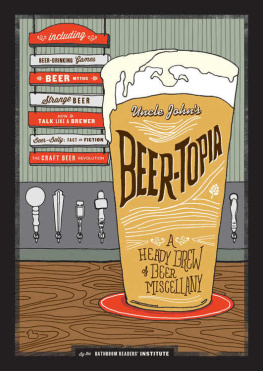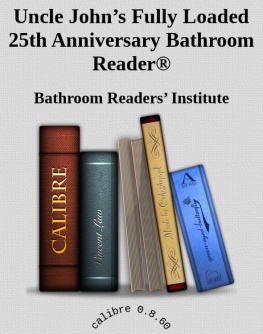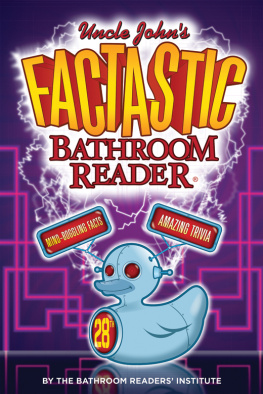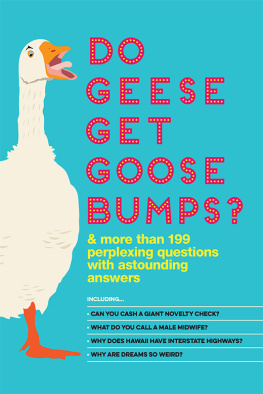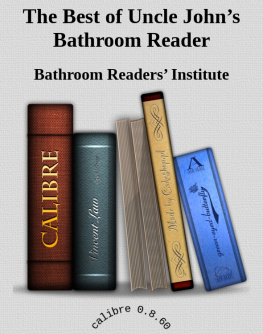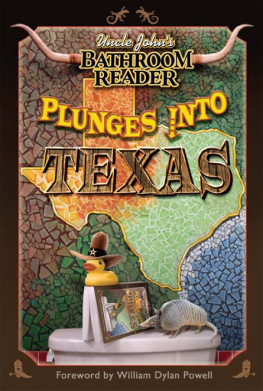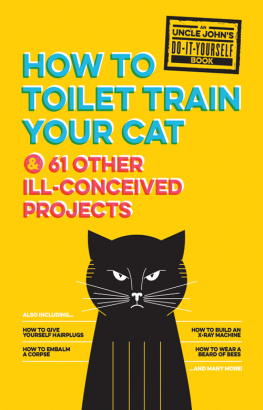
You from within our glasses, you lusty golden brew, whoever imbibes takes fire from you. The young and the old sing your praises. Heres to beer, heres to cheer, heres to beer.
Bedrich Smetana, The Bartered Bride (1865)

UNCLE JOHNS BEER-TOPIA
Copyright 2015 by Portable Press.
All rights reserved. No part of this publication may be reproduced, distributed, or transmitted in any form or by any means, including photocopying, recording, or other electronic or mechanical methods, without the prior written permission of the publisher, except in the case of brief quotations embodied in critical reviews and certain other noncommercial uses permitted by copyright law.
Portable Press is an imprint of the Printers Row Publishing Group A Division of Readerlink Distribution Services, LLC
Bathroom Reader, Portable Press, and Bathroom Readers Institute are registered trademarks of Readerlink Distribution Services, LLC.
All rights reserved
For information, write: The Bathroom Readers Institute,
P.O. Box 1117, Ashland, OR 97520
www.bathroomreader.com
Cover and interior design by Andy Taray Ohioboy.com
Library of Congress Cataloging-in-Publication Data
Uncle Johns beer-topia.
pages cm
ISBN 978-1-62686-375-0
1. Beer--Humor. 2. Beer--Anecdotes. I. Bathroom Readers Institute (Ashland, Or.) II. Title: Beer-vana.
PN6231.B43U53 2015
818.607--dc23
2014041247
First Printing: March 2015
1 2 3 4 5 19 18 17 16 15
THANK YOU!

The Bathroom Readers Institute sincerely thanks the people whose advice and assistance made this book possible.


CONTENTS

CHEERS!

Were in the middle of a beer revolution. Theres nothing wrong with that canned stuff people used to drink at the bowling alley, but beer is a whole new animal these days. Were talking about the rich, intricate concoction brewed in small batches by innovative brewers all across the nation. And these brewers are true heroes, carefully selecting everything that goes into our beer, from the water, to the hops, to the goofy name they slap on the label. The world of beer has become, in short, a Beer-Topia. (Just like the name of this book!) And as it turns out, its almost as much fun to read about beer as it is to drink it. (Almost.) So pour yourself a glass of beer-flavored words. Some of whats on tap:
The best local beer in every state
How to perfectly pour a beer, and into just the right glass
The strangest-tasting and most expensive beers
Whats really in a beer, and who really made it
And barrels more!
Whether youre a seasoned beer snob, a novice, or a homebrewer, theres something for you in the Beer-Topia.
UNCLE JOHN AND THE BATHROOM READERS INSTITUTE

Despite all the hundreds if not thousands of varieties of beer out there, there are really only two main types of beer: ales and lagers. On the great beer family tree, this is the basic fork that divides every drink, and it all comes down to the brewing process.
Ales are made with top-fermenting yeast, which is active at higher temperaturesaround 60 to 75 degrees Fahrenheitand ferment quicker, usually over a week or so, but sometimes even less. They also produce esters, the fruity or flowery scents detected by drinkers with refined palates.
Lagers, meanwhile, are brewed using bottom-fermenting yeast, which is active in colder climes (around 34 degrees). These drinks mature more slowly, in cold storage, and tend to have a hoppier flavor profile.

Wheat Beer/Hefeweizen. The granddaddy of beer, this brew is generally regarded as the oldest style that still has any sort of widespread popularity, and its pretty much what it sounds like: beer brewed with a mixture of wheat and barley. The traditional recipe, still used to produce Bavarian hefeweizen, calls for a 50/50 blend between the two, although wheat can gobble up a much higher percentage, plus noble hops, ale yeast, and water. Low on hops flavor and generally softer than some of its cousins in the ale family, it tends to possess a cloudy appearance due to the wheat proteins in the brew, both in its traditional form and in Belgium, where unmalted wheat is combined with spices to produce white beers such as Hoegaarden.
Pale Ale. This is a broad term used to describe all kinds of beer, but it all got its start in the early 18th century. Some frustrated brewers at the Burton-on-Trent brewery in England started looking for alternatives to wood-fired kilns, whose unpredictable heat gave barley too dark a roast and often scorched the inventory. Turning to coke (processed coal) for their new heat supply, they discovered it was easier to control, allowing for a lighter roastand in turn, a paler beer. In the UK, if you hear someone refer to a pint of bitter, thats pale ale, and it ranges from low-alcohol by volume light brews (occasionally referred to as boys bitter) to the higher alcohol ends of the spectrum, spanning ordinary to premium and best bitters. Elsewhere in the world, pale ales tend to diverge from the maltier British brews; in the U.S., they can be almost as hoppy as India pale ales while still maintaining that light brown hue.

Next page
